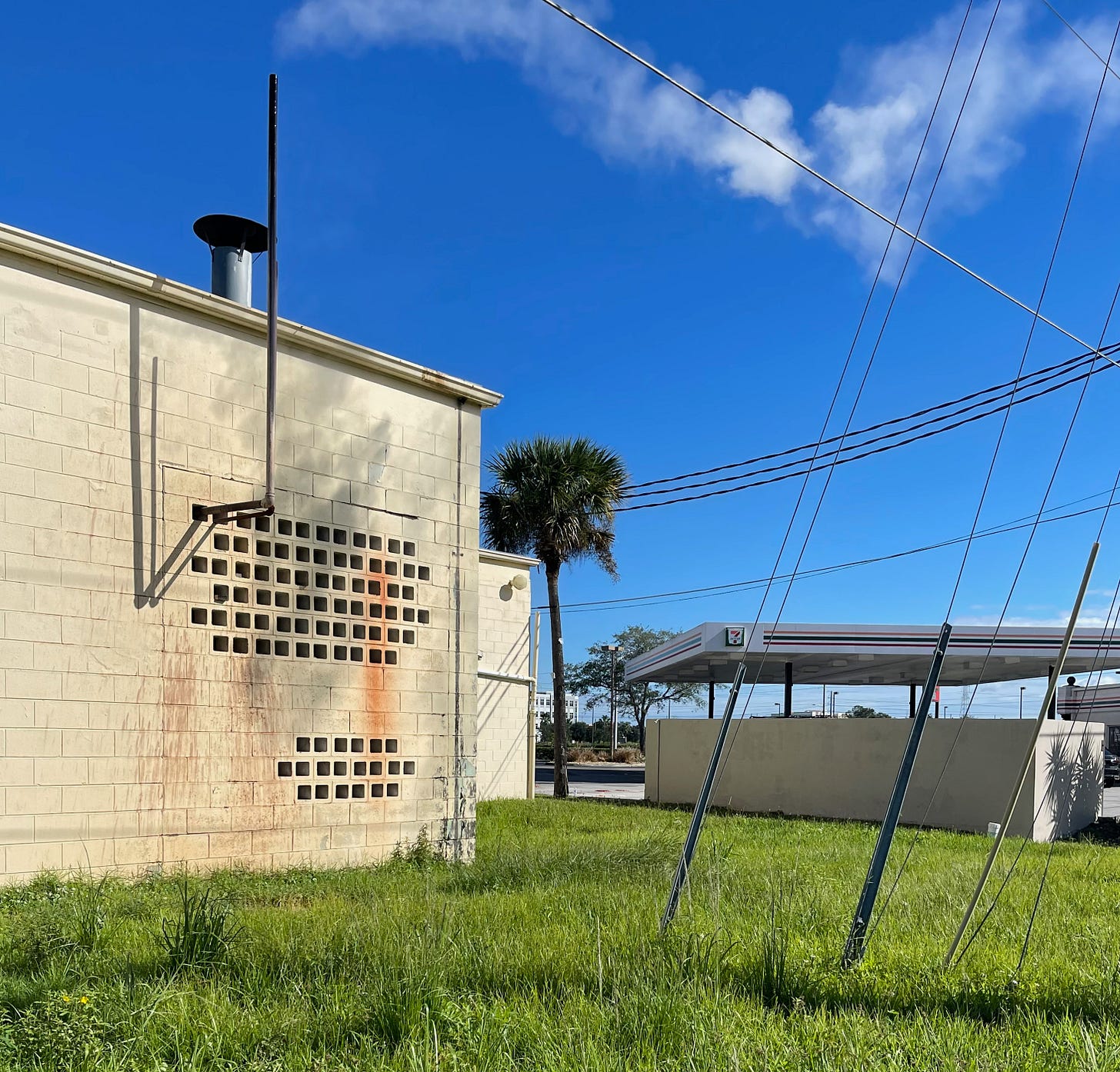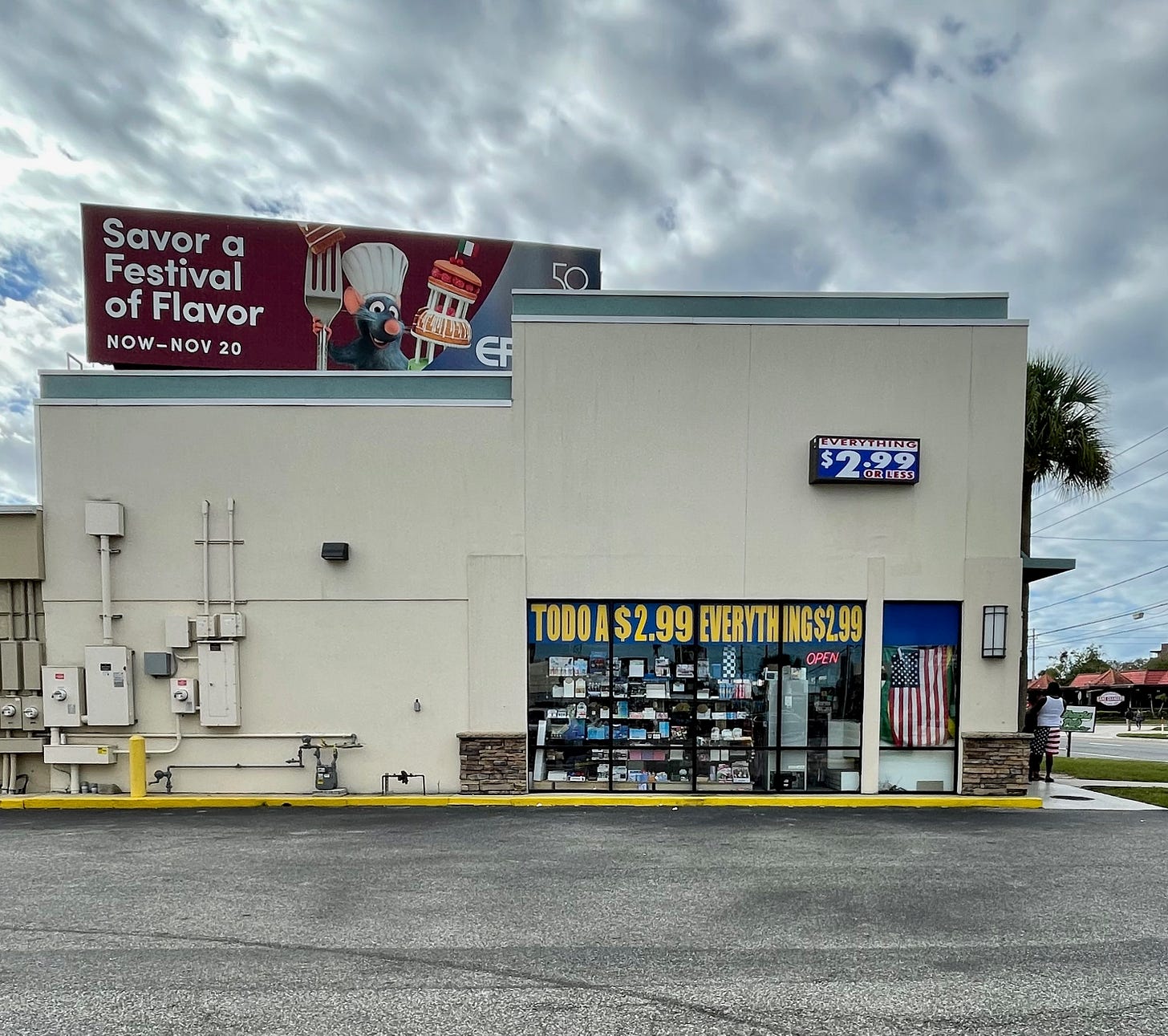Walking America: Orlando
A small taste of what our pod living, bug eating, future looks like.
Orlando is known for Disney because Disney made the Orlando of today, turning it from a small cow town into one of America's fastest growing cities and the world's number one tourist destination.
Disney also gave Orlando its organizational blueprint, as a collection of different themed lands, all connected by a monorail. Instead of Adventureland, Tomorrowland, and Frontierland, Orlando has Convention-center-land, Tourist-land, Rich-people-land, Poor-people-land, Poor-black-people-land, Recent-immigrants-fleeing-Latin-America-looking-for-any-type-of-work-land, all connected by highways, toll roads, parkways, and brutal eight-lane roads.
The result is a sprawling ill-planned mishmash of very highly planned smaller communities, of massive amusement parks adjacent to strip mall sprawl adjacent to clusters of high-rent gated communities adjacent to more strip-mall sprawl adjacent to termite-mound-like high rises adjacent to even more strip-mall sprawl adjacent to trailer parks adjacent to clusters of low-rent gated communities adjacent to sections filled with by-the-month hotels and so on and so on.
It keeps sprawling for mile after mile, with the boundaries between the dramatic changes marked by the highways, toll roads, parkways, and brutal eight-lane roads that dominate Orlando.
Since I was in Orlando to report on a convention, my twenty-mile walk began in Convention-center-land, in the SE corner of Orlando, adjacent to a tourist-land comprised of Disney and other amusement parks that have globbed onto the scene.
Like so much in Orlando, Convention-center-land is highly and overly engineered, a soulless place of massive hotels, airport-terminal-like buildings, bland bars, bland restaurants, and ugly corporate public art, all lying along unnecessarily windy roads (presumably to hide the full grid like dreariness).
It is designed to ingest and disgorge tens of thousands of people daily, all excited for PowerPoint presentations, Hooters, Buffalo Wild Wings, and strip clubs. None of it is designed to be lived in beyond a few days.
Next on my walk, four miles to the north, comes Middle-to-low-brow-tourists-on-a-tighter-budget-wielding-close-to-maxed-out-credit-cards-land. The official boundary between the two is another eight-lane road.
This land also isn’t focused on living, but on catering to tourists looking to splurge, although it is far more low brow because the tourists are far less rich. There are tattoo parlors, pubs, one of every fast-food franchise known to man, sexy lingerie shops, stores selling knock-off Disney themed stuff, and more sexy lingerie shops.
After three miles of this (7 miles in total since I began) I am forced by an interstate and parkway to veer directly east, into the first Residential land I have seen.
Gone are the amusement parks, hotels, and themed restaurants, and now comes four miles of gated communities, strip malls, and trailer parks. The gated communities, like so much else in Orlando, are highly designed, and have copied Disney’s faux stage-set ethos. Their winding roads have silly names like “Tally Ho Drive,” their ponds are really only drainage pools with fountains to stop the mosquitoes from laying eggs, and the palm trees look like they have only been planted to fulfill some regulation about greenery.
This seems to be Lower-to-middle-class-land. A diverse mixture of Hatians, Latinos, and whites, all united by not having very much money.
Despite its backbone being one Orlando’s ubiquitous eight lane roads, it is a relaxing, sweet, and even charming neighborhood, with a sense of community and place heightened by contrast with what came before. I spot my first church, my first elementary school, then more churches, then a Hindu temple, then a community college. Then sadly, my first marker for a pedestrian killed by a car. Something Orlando apparently does at a greater rate than almost anyplace in the US.
People do live, and die, in Orlando it seems.
After three or for miles of this, I again turn north along the Orange Blossom Trail, another eight-lane road, that somehow is even busier than any other road.
I am now in Commerical-land, and I walk four miles past auto dealers, auto-body shops, grocery stores, Cricket stores, strip clubs, gun shops, dive bars, strip malls, flea markets, more strip clubs, more strip malls, more fast-food restaurants, and by-the-hour motels. Despite little sign of anyone living here, despite the constant overwhelming noise of cars zipping by only feet away, and despite having to constantly dodge them as they cross the sidewalk, there is a human side thriving here.
In the packed and small parking lot of a Latino fish store, there is some sort of religious revival, a crowd with hands held high, singing and swaying to a band just loud enough to drown out the cars.
There are people tired from a day's work, slouched in bus stops, chatting with each other, gossiping while they hide from the sun.
There is a party, complete with BBQ smoker, DJ table with tall speakers, grand arches of balloons, and a roped-off dance floor filled with dancers, all in an auto parts store parking lot.
Finally, I come to the last part of the walk. After passing under an interstate, I enter Urban-Black-poverty-land, something every US city has, although in Orlando it is made more depressing and jarring by what came before. This is supposed to be the city of grand magic, dreams come true, fantasies fulfilled, and escape from the ordinary, and none of that seems to be here.
Instead I pass liquor stores, pawn shops, topless bars, bail bondsmen, but very few restaurants, offices, or coffee houses. This could be East Buffalo, or South Chicago, or Compton. Every city has Urban-Black-poverty-land, and the entire country should be ashamed every city has it.
After four miles of this, I am finally done with my walk (about eighteen miles all told), the sun is setting, and I catch a ride back to a strip mall fifteen miles down the Orange Blossom Trail, to have dinner in the small fantastic Mexican restaurant, Taco Express, where I chat with friends and watch large Mexican-American families celebrate birthdays, anniversaries, and just being families.
I am forced to spend the next three days back in Convention-land, because that is where my hotel is. When I am able to escape, I have to drive, since getting out requires a four-mile-plus walk, and then in only two directions. Everything else is blocked by roads built with no pedestrian in mind. Beyond perhaps killing them.
Despite that, I make it back to Taco Express three more times, and the other two nights I spend in a Hondoran place on Orange Blossom Trail, El Pulgarcito Grill and Bar, where I have to deal with the awkwardness of overly polite and drunk working class guys who can barely make rent insisting on buying me, a guy who retired at forty-eight, drinks. I desperately try to decline, but their English isn’t good, my Spanish non-existent, and they assume I am scared of them, rather than being polite. When I try to reciprocate, and buy them a drink, they almost tackle me, “You are our guest.”
Sitting at the Denny’s on my last night, I am not sure what I think of Orlando. It wasn’t all that fun to walk across. While the sidewalks were all there, the crossing lights functional, I was always second fiddle to the car. Like Disney has the monorail, Orlando has the car.
At the macro level is is a soulless town. A patchwork of cocooned gated communities connected by brutal “transportation!”
In many ways it is the first step towards the hated and roundly mocked future our politicians seem to want for us. One where plebes live in pods watching content, while hooked up to a bug slurry IV. But instead of bug slurry, it is Buffalo Wild Wings, which you have to drive to first before it can be injected into you.
Everyone involved — city planners, the politicians, Disney, developers — have done their best to make Orlando a place devoid of organic community. They have done their best to build a city that squeezes out the human soul.
Despite that, there is a soul here. You find it inside places like Taco Express, where on a Tuesday night a family is throwing their daughter a quinceanera celebration. You find it outside Taco Express at the idling BBQ food truck, where a young mother hugs her daughter, while their grandfather buys them a meal.
You even find it in Convention-center-land, where in the Denny’s, at 2 am, you watch a young waitress walk into the parking lot and hand the homeless man you have seen over last three days living in the nearby McDonald’s a brown bag with a full meal.
There is a soul even here, in Convention-center-land, the most soulless place ever. Because that is just how us humans are.
Walk Details



























Not far over from OBT you would’ve seen the Pulse memorial, memorializing an event that defined a piece of Orlando and intersects multiple unique communities.
You also weren’t far from the Vietnamese neighborhood off Colonial- a close-knit community (and authentic pho).
Puerto Rican community all up Semoran Rd.
The city stays young bc a top five largest university in the country is here.
There’s a lot of character in Thornton Park, College Park, winter park, and Windermere though not the back row you were seeking.
You walked through the convention center part of town then up OBT. You’re going to see things catering to convention-goers/tourists and johns respectively.
Chris, I’m a little embarrassed by my earlier comment because I knew nothing of your personal backstory, your story on Orlando had been sent to me by a friend, so I just wrongfully assumed you were just some talented blogger that deserved some much earned praise. I wanted to make sure you continue to do what you do so well, I can see now from your level of dedication to photography and writing that of course that concern is irrelevant. Keep up the outstanding work, I’m just now checking out your work on Flickr and hope to see your recent book as well, best of luck and stay safe.